DSA Week 5: Endocrine System
Topic 1: Glands + Hormones
Glands:
produce hormones in response to stimuli
stimuli:
hormone signals
environmental signals
signals from nervous system
specialised organs that produce + secrete hormones
Hormones:
chemical substance secreted by glands
in response to stimuli
can be messengers to other glands
Receptors:
proteins that bind with hormones to trigger a response
Glands in the human body:
Hypothalamus
controls growth, development, metabolism
regulate other glands by controlling the pituitary gland
Pituitary Gland:
“master gland”
anterior (produces + secretes): growth hormone, prolactin (milk), FSH (follicle stimulating hormone), LH (luteinising hormone), thyroid stimulating hormone (stimulates the thyroid gland), adrenocorticotropic hormone (stimulates adrenal gland)
posterior (secretes): oxytocin + ADH
Thyroid Gland:
produces thyroxine T4, Triiodothyronine T3
controls body’s basal metabolic rate
Parathyroid Gland:
produces parathyroid hormone
regulates calcium, magnesium + phosphate in the blood
Adrenal Gland:
produces cortisol + aldosterone (maintains electrolyte balance Na+/K+)
adrenaline + noradrenaline (fight/flight)
Pancreas
secretes insulin + glucagon
regulates blood sugar levels
Gonads
secretes estrogen + testosterone
controls growth of reproductive organs
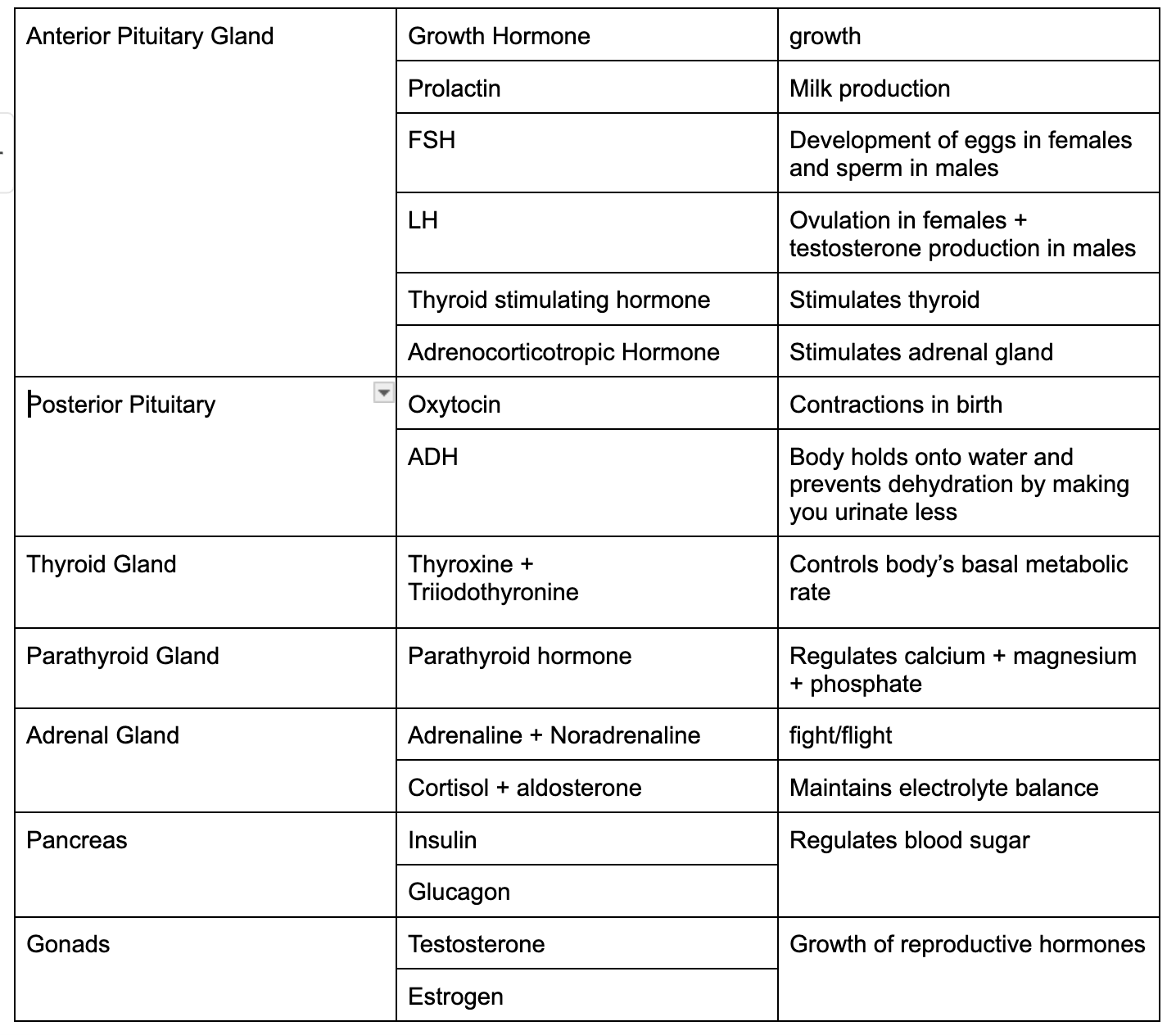
Topic 2: Differences in Endocrine + Nervous System Signalling

Nervous: fast delivery, short lasting SHEIN
Endocrine: slow delivery, long lasting
Topic 3:
hormone only affects “target cells” - target cells are target because of their receptors to the hormone:
hormone can:
secretion
transport (opening/closing ion channels)
deactivation
synthetis
proliferation
3 TYPES OF STIMULI
Humoral stimuli
ion/nutrient levels in the blood
Neural stimuli
The hypothalamus controls the pituitary gland.
Hypothalamus tells the posterior pituitary to release ADH and oxytocin
Sympathetic nervous system controls the release of adrenaline + noradrenaline from the adrenal glands.
Hormonal stimuli
hypothalamus secretes hormones
causes the anterior pituitary gland secrete hormones
causes other glands to secrete hormones
Topic 4: Factors that impact hormone activity
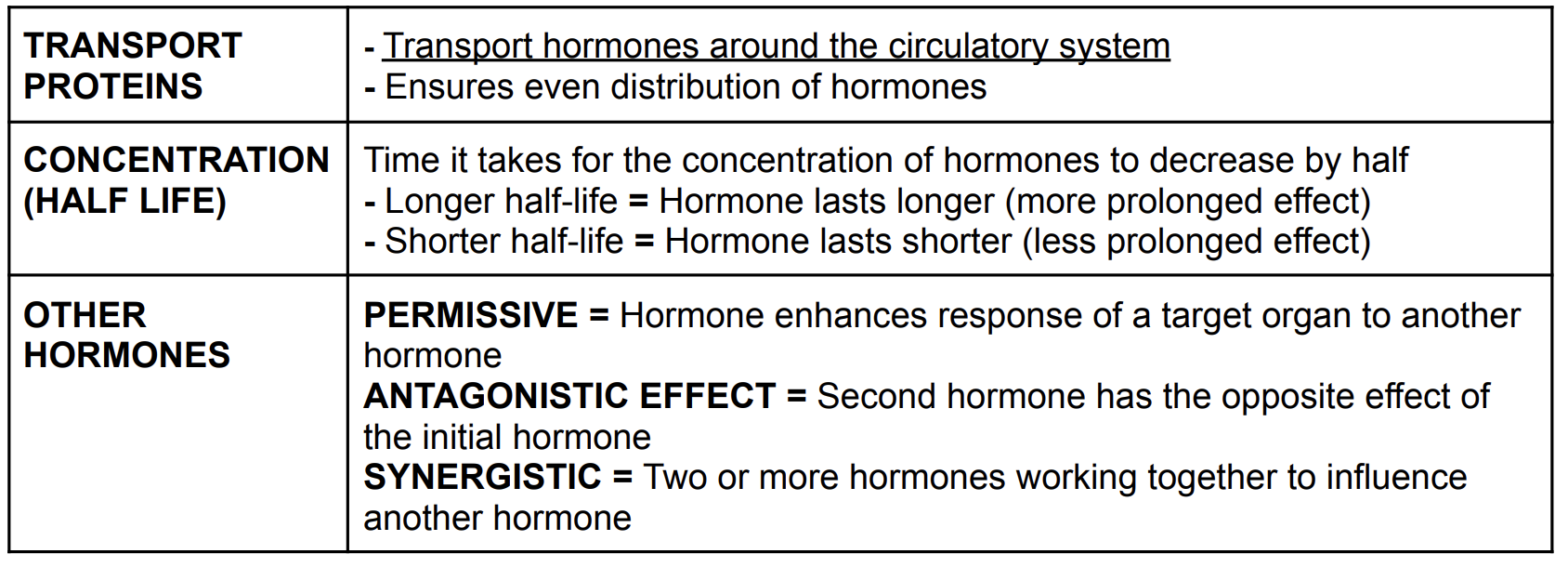
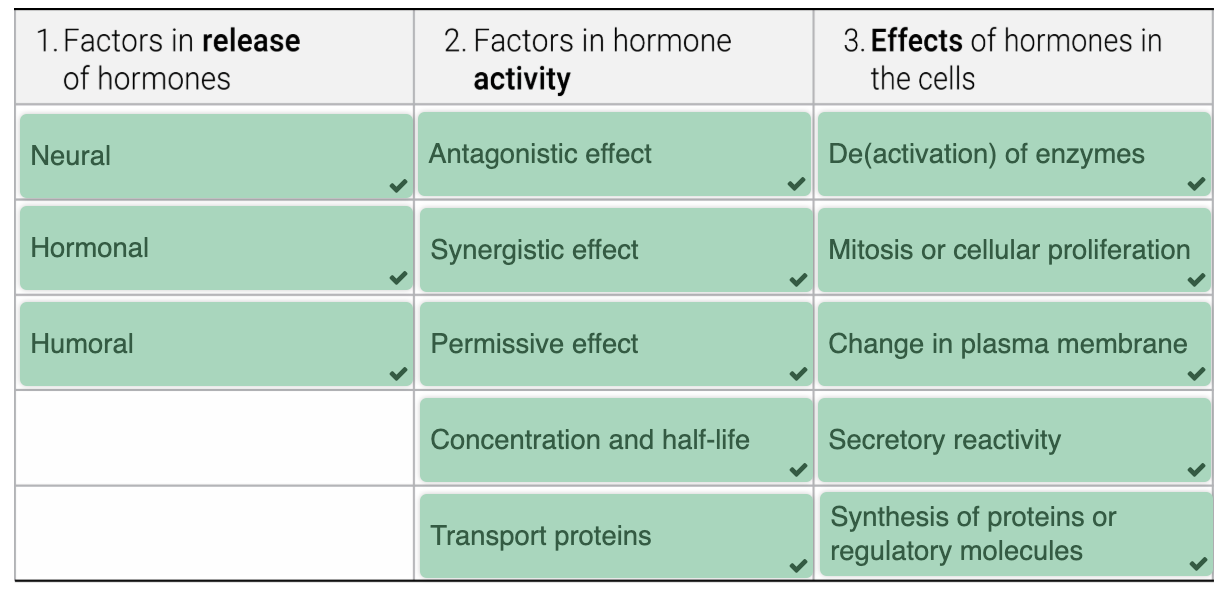
Topic 5: Chemical Structure of Hormones
2 Classes of hormones:
Amino acid based
includes proteins, peptides, amines
made from chains of amino acids
most hormones are amino acids
water soluble (blood carries it)
lipid insoluble (receptors must take it inside the cell)
Steroids (derived from cholesterol)
lipid soluble (must bind to a hormone carrier to be transported in the blood)
either a specialised hormone carrier or albumin (public transit)
receptors are inside the cytoplasm/nucleus
Lipid Based Hormone Signalling
steroids are carried through the blood by a carrier
when it reaches a target cell, it binds to a receptor
receptor changes shape
that causes chaperone to be released
receptor + hormone binds to a part of the DNA called “hormone response element”
causes activation of certain genes
causes protein production = reaction
diffuses straight through the phospholipid bilayer
Amino acid Based Hormone Signalling
Bind to receptors on the membrane that change shape and release GDP
GDP is converted into GTP
G protein activates when it binds to GTP
G protein binds to and activates Adenylate Cyclase
Adenylate Cyclase converts ATP into cAMP
cAMP causes enzymes to create cellular response
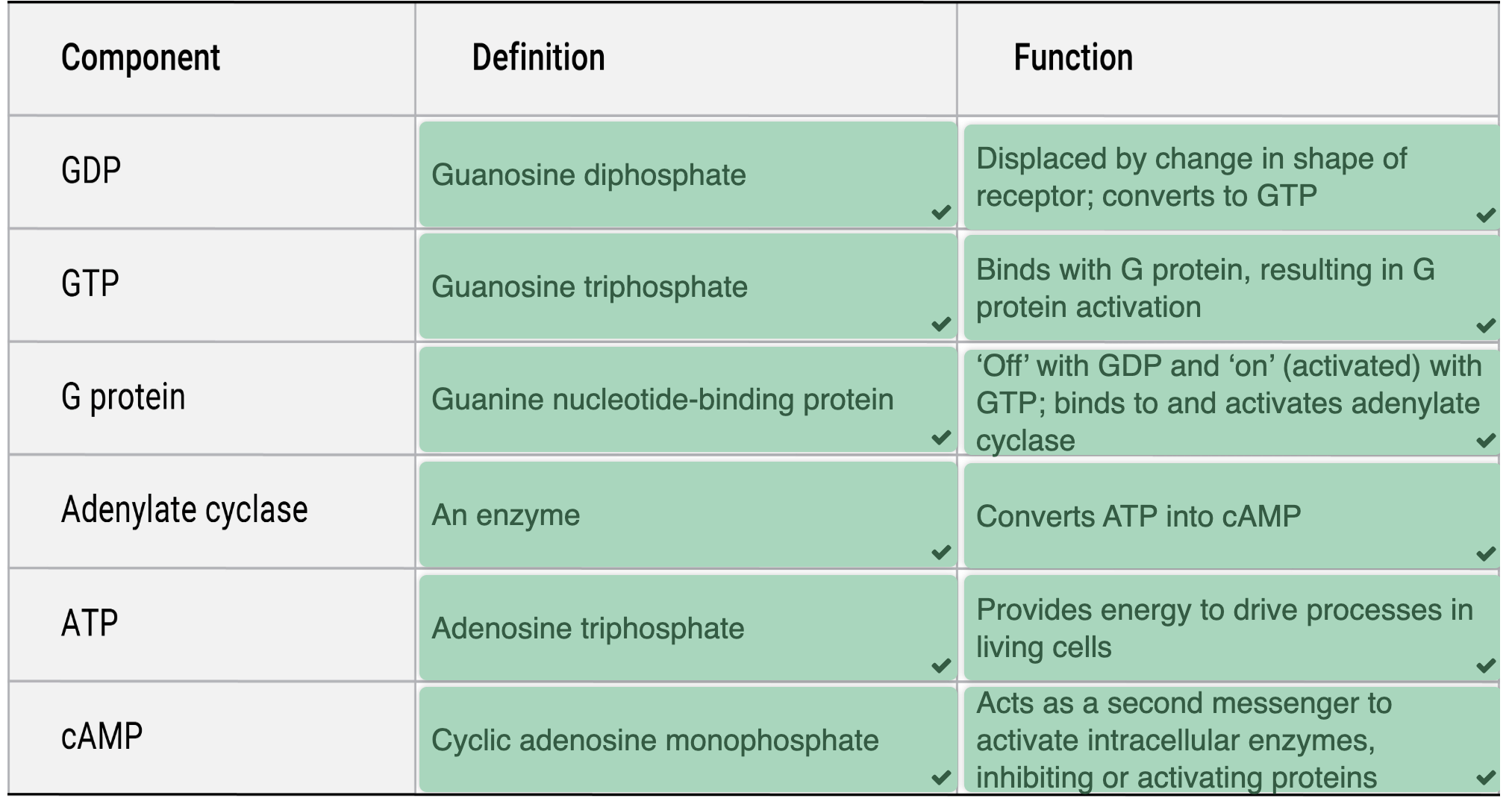
Topic 6: Hypothalamus, Pituitary Gland + Thyroid Gland
Hypothalamus — anterior pituitary gland
Hormones are controlled when hypothalamic neurons secrete releasing and inhibiting hormones into the hypophyseal portal system, the blood vessels connecting the hypothalamus to the anterior pituitary.
Hypothalamic hormones travel through the hypophyseal portal system to the anterior pituitary where they stimulate or inhibit glandular cells to release hormones from the anterior pituitary.
Anterior pituitary hormones are secreted into the secondary capillary plexus, or blood vessels, for distribution throughout the body.
Hypothalamus — posterior pituitary gland
The posterior pituitary is controlled by hypothalamic neurons. Oxytocin is made primarily by the paraventricular neurons. Antidiuretic hormone (ADH) is made by the supraoptic neurons.
Oxytocin and ADH are transported along nerve axons through the hypothalamic hypophyseal tract to the posterior pituitary.
They are then stored in axon terminals in the posterior pituitary.
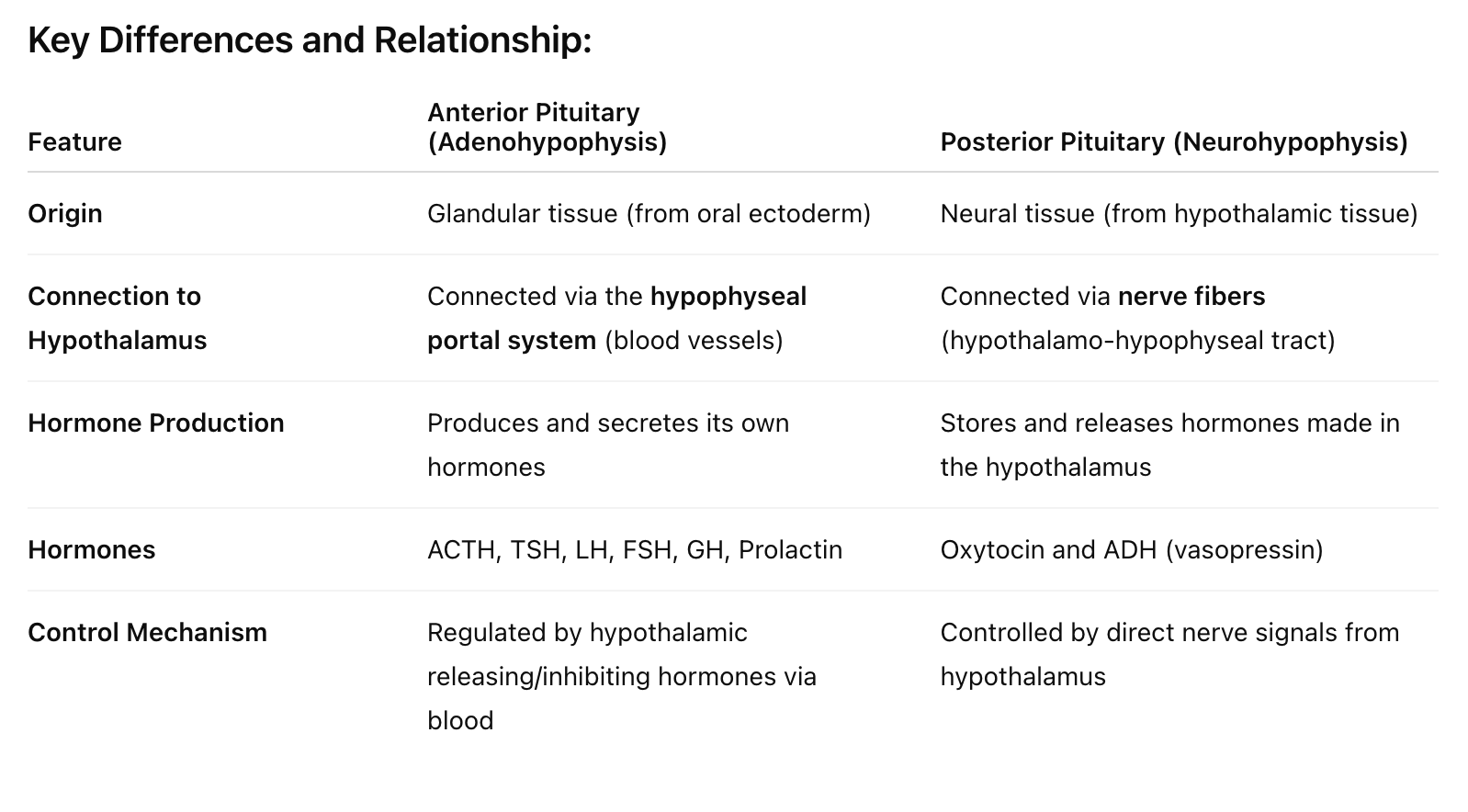
Hypothalamus — thyroid relationship
When thyroid hormone levels are low, the hypothalamus produces thyrotrophin releasing hormone or TRH.
TRH stimulates the anterior pituitary to produce thyroid stimulating hormone or TSH.
TSH signals the thyroid to increase production of its hormones.
When blood levels of thyroid hormones increase, they feedback to the hypothalamus and anterior pituitary gland causing a decrease in production of TRH and TSH, in a negative feedback loop, to maintain appropriate levels of thyroid hormones.